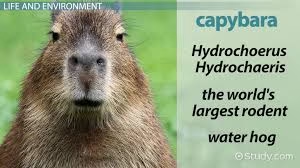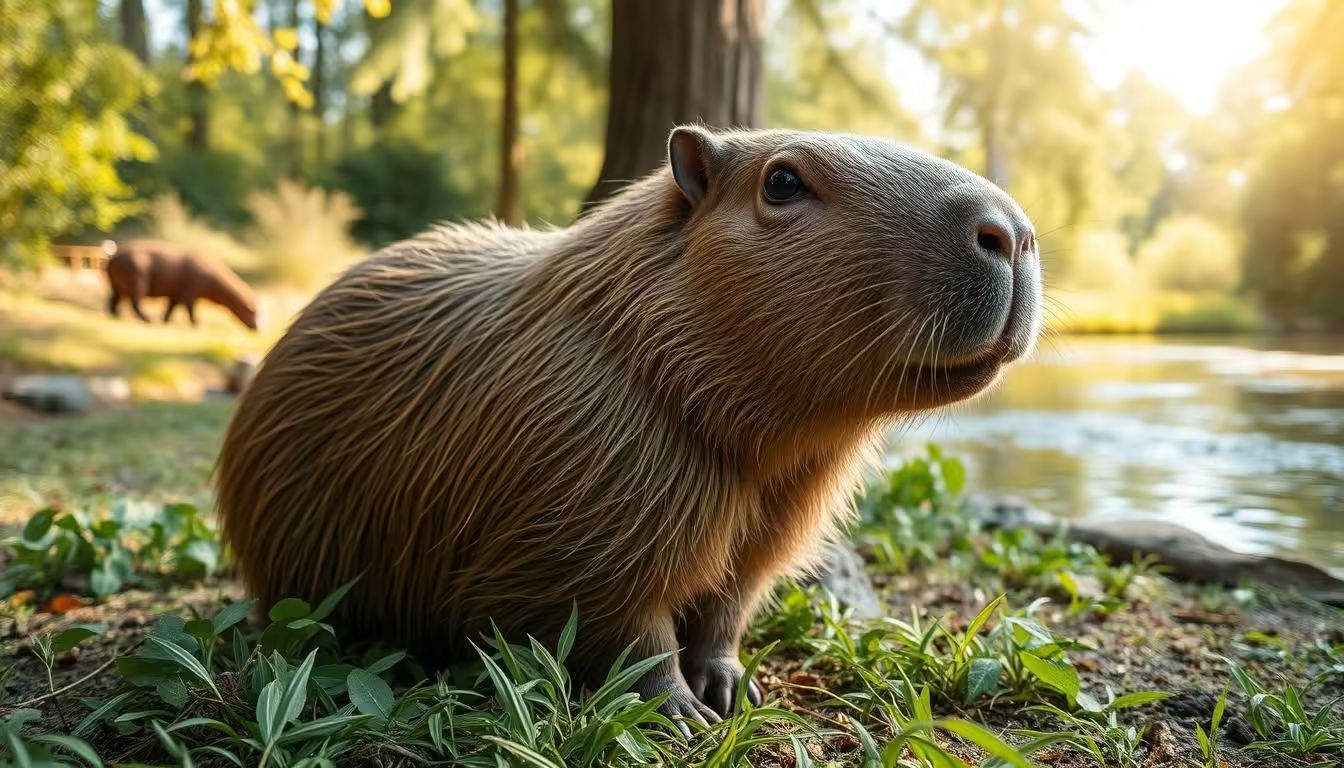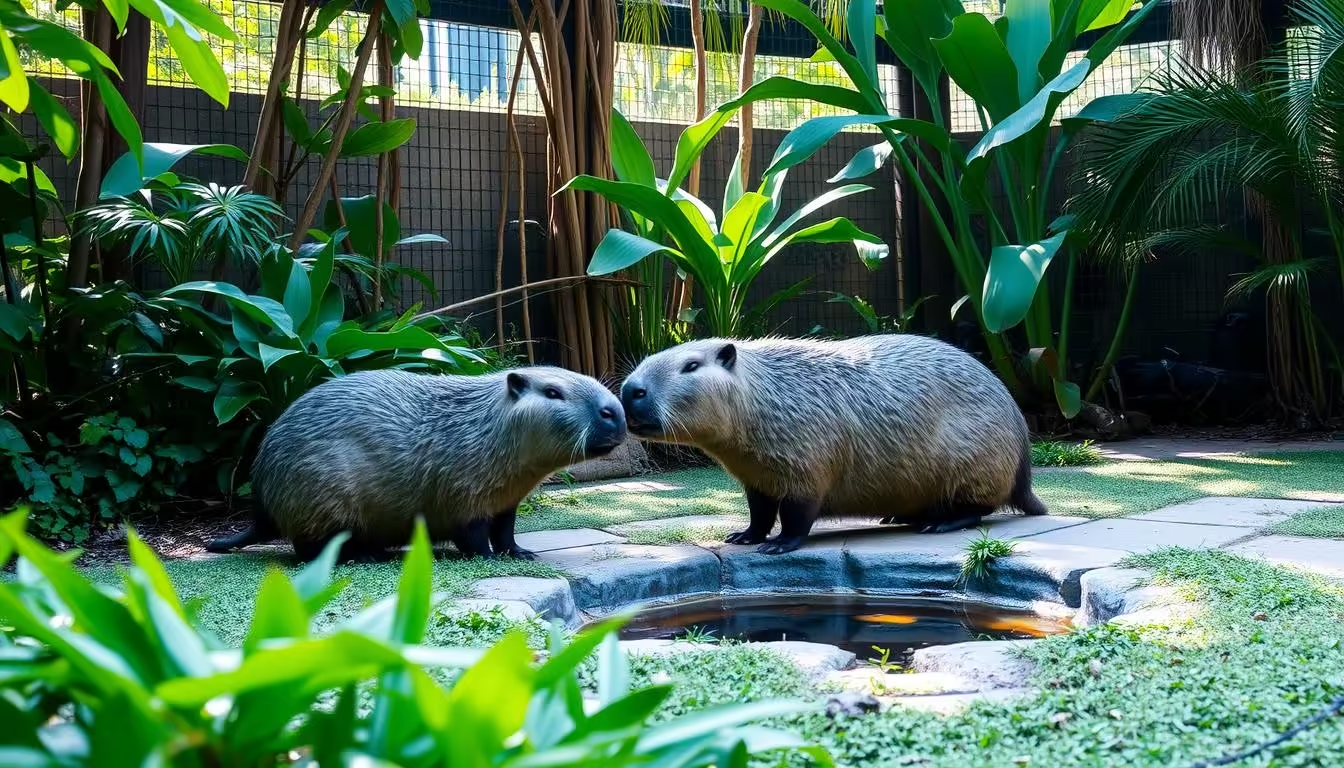Genetic Makeup of Capybaras
The capybara, the world’s largest rodent, has a fascinating genetic makeup. It weighs about 55 kg. This is much bigger than its closest relative, the rock cavies, and about 2,000 times bigger than a common mouse.
Scientists have analyzed the capybara’s genome. They found it to be 2.73 Gb long. This is slightly shorter than what flow cytometry estimated at 3.14 Gb. The genome has 73,920 contigs, with an N50 of 12.2 Mb and a GC content of 39.79%.
The capybara genome shows a high ratio of non-synonymous to synonymous substitutions. This suggests a high mutation load linked to its gigantism. Gene expansions in the insulin/insulin-like growth factor signaling pathway are also involved in growth regulation.
The genome also points to a possible anticancer mechanism through T cells. This could explain why gigantic animals like capybaras have lower cancer rates. Capybaras have more slightly deleterious mutations than other rodents. This shows their evolutionary adaptations for size and longevity.
“The evolution of gigantism in the capybara likely involved three evolutionary steps: increase in body size by cell proliferation through the IIS pathway, evolution of growth-regulatory and cancer-suppression mechanisms, and establishment of the T cell-mediated tumor suppression pathway.”
The capybara’s genetic makeup is key to understanding body size evolution and cancer suppression. It offers insights into rodent genetics and mammalian biology.
Are There Any Genetic Disorders That Shorten Capybara Lifespan?
While we don’t know much about genetic disorders in capybaras, their genome shows interesting patterns. They have more mutations than other rodents, possibly due to their size and small population. This could affect their lifespan and health.
Common Inherited Conditions
Some inherited conditions might shorten a capybara’s life. These include:
- Telomere abnormalities: Their size and small numbers might lead to shorter telomeres. Telomeres are important for aging and cell division.
- Gigantism-related disorders: Their big size might also raise the risk of health problems like heart issues or metabolic disorders.
- Immune system deficiencies: Captive populations with less genetic diversity might be more prone to diseases and immune problems.
Impact on Survival Rates
Genetic disorders in capybaras can greatly affect their survival. Shorter lifespans and lower fitness make them more vulnerable. They face more challenges from predators, the environment, and health issues.
Detection and Diagnosis Methods
Finding and diagnosing genetic disorders in capybaras is hard due to limited research. But, new advances in veterinary genetics and genomics help. They give us insights into capybara genetics, helping us manage inherited conditions better.
Studying capybara genetics further will help us understand their health better. This knowledge will lead to better conservation and management of these animals.
Role of DNA Mutations in Capybara Health
The capybara, the world’s largest rodent, has a fascinating genetic makeup. It holds clues about its remarkable physiology. Capybara DNA shows evidence of adaptive protein evolution in genes controlling postnatal bone growth regulation and musculoskeletal development. These genetic changes are likely related to the evolution of their large body size, a signature trait of this unique species.
While these genetic adaptations have enabled capybaras to thrive in their natural habitats, DNA mutations can also play a role in potential health risks. Interestingly, research has found that rodent mutations can have a significant impact on lifespan and susceptibility to certain diseases, including cancer.
| Statistic | Comparison |
|---|---|
| Approximately 50 to 90% of aged mice die of cancer | In humans, this number is approximately 23% |
| It takes a mouse an average of two years to develop cancer | It takes decades for long-lived species |
| Humans require five hits to transform fibroblasts | Mice need two hits for malignant transformation |
These striking differences highlight the unique genetic mechanisms at play in capybara DNA and other large-bodied species. Understanding the role of DNA mutations in capybara health is crucial for preserving the well-being of these remarkable animals. It also unlocks the potential of their genetic adaptations for future medical breakthroughs.
“There is a defined body mass threshold of 5,000-10,000 g after which telomerase is repressed in the majority of somatic tissues in species with large body masses.”
This intriguing finding suggests that capybara DNA may harbor unique strategies for regulating cell growth and division. This could have implications for their longevity and disease susceptibility. Ongoing research in this area promises to shed more light on the intricate relationship between genetics, body size, and overall health in these remarkable rodents.
Impact of Gigantism on Capybara Genetics
Capybaras, the world’s largest rodents, have a unique trait called gigantism. This trait lets them grow to impressive sizes. But, it also raises their risk of getting cancer.
Cell Proliferation Challenges
The fast growth and division in capybaras increase the chance of genetic mistakes. These mistakes can lead to cancerous cells.
Cancer Risk Factors
- Increased cell numbers: The more cells in a capybara, the higher the chance of cancerous mutations.
- Faster cell division: Quick cell division means more chances for DNA errors and chromosomal problems.
- Genomic instability: Fast growth can damage the genome, making capybaras more likely to get cancer.
Interestingly, capybaras have special genes that might help fight cancer. These genes could be part of their defense against cancer linked to gigantism.
“Gigantism in capybaras is achieved through increased cell numbers and higher rates of cell proliferation, potentially increasing cancer risk due to more opportunities for mutations.”
| Trait | Acceleration Rate |
|---|---|
| Body size evolution in sea turtles | 29x rate increase |
| Body size evolution in leatherback sea turtles | 103x rate increase |
| Body size evolution in soft-shell turtles | 37x rate increase |
| Body size evolution in narrow-headed softshell turtles | 200x rate increase |
| Body size evolution in Cantor’s giant softshell turtle | 463x rate increase |
The genetic traits that make capybaras big also pose health challenges. It’s important to understand how cell growth, genetics, and cancer risk interact. This knowledge helps keep these amazing rodents healthy, whether they’re in the wild or in captivity.
Hereditary Disease Patterns in Captive Populations
Captive capybaras face special genetic challenges. Their breeding programs have less genetic diversity. This can cause recessive genetic disorders that are rare in the wild. It’s important to study these diseases to keep captive capybaras healthy.
Genetic disorders could shorten the life of captive capybaras. Rodent hereditary diseases can harm their health and survival. It’s key to find and manage these diseases well.
Capybara captive breeding can lead to harmful genetic traits. These can cause metabolic problems, skeletal issues, and brain damage. It’s vital to watch and test captive animals for these diseases early.
- Reduced genetic diversity in captive populations can lead to the expression of recessive genetic disorders.
- Specific hereditary disease patterns in captive capybaras are not well-documented, requiring further research.
- Potential genetic disorders in captive capybaras may include metabolic imbalances, skeletal abnormalities, and neurological impairments.
- Genetic screening and monitoring of captive populations are crucial for early detection and management of hereditary diseases.
Researchers and wildlife managers need to understand the genetic challenges of captive capybaras. This knowledge helps in keeping these animals healthy in controlled settings. More research and monitoring are needed to protect captive capybara populations for the long term.
Environmental Factors Affecting Genetic Expression
Capybaras are the world’s largest rodents and eat mostly grasses and plants. Their diet and environment can change how their genes work. This can affect their health and how long they live. Stress can also play a big role, especially in captive capybaras or areas with lots of people.
Diet and Genetic Interaction
The capybara environment and their rodent epigenetics are closely linked. Their diet, mainly plants, can change how genes work. This includes genes for metabolism, immune function, and more. Changes in what they eat can lead to changes in gene expression, affecting their health and lifespan.
Stress-Related Genetic Responses
Captive capybaras or those in busy areas may feel more stress. Stress can change how genes work, affecting their health and behavior. It’s important to understand how stress and genetics interact. This helps us keep capybaras healthy and long-lived.
“Unraveling the complex interactions between the capybara environment and their rodent epigenetics is essential for preserving the long-term health and survival of these remarkable creatures.”
Prevention and Management Strategies
Keeping capybaras healthy and long-lived needs a mix of strategies. Capybara conservation and rodent health management focus on watching for age-related diseases. They also work to keep genetic diversity in wild populations to avoid genetic problems.
It’s important to watch for cancer and other age-related diseases in capybaras. Their big size and genetics make them prone to health issues. Early detection is key for treatment and management. Regular vet visits, screenings, and health checks help catch problems early.
Conservation efforts also aim to keep wild capybara populations genetically diverse. A strong gene pool helps avoid genetic disorders. This means using strategic breeding, saving habitats, and managing populations to help genes spread.
| Key Strategies for Capybara Health Management | Potential Benefits |
|---|---|
| Regular health monitoring and screening | Early detection of age-related diseases and genetic disorders |
| Maintaining genetic diversity in wild populations | Reduced risk of inheritable genetic issues |
| Implementing strategic breeding programs | Promotion of genetic diversity and healthy offspring |
| Habitat conservation and population management | Facilitation of natural dispersal and gene flow |
Using a detailed, science-backed approach to capybara conservation and rodent health management helps these amazing rodents thrive. Through teamwork and research, we protect their genetic health. This ensures their well-being in both captivity and the wild.
Current Research and Future Perspectives
Scientists are studying capybara genetics to learn about their big size and possible cancer resistance. They aim to find out how capybaras live long and stay healthy. This research could help both animals and humans.
Ongoing Studies
Researchers are looking into why capybaras grow so big and adapt well to different places. They compare the capybara’s genes to other rodents. This helps them find important genetic traits for the capybara’s size and adaptability.
Emerging Treatment Options
As we learn more about capybara genetics, new treatments might be developed for genetic diseases. Gene therapy, targeted drugs, and personalized medicine could help capybaras and other rodents. The findings from capybara research and rodent genetics studies could also help other endangered species and our understanding of genetic disorders.



